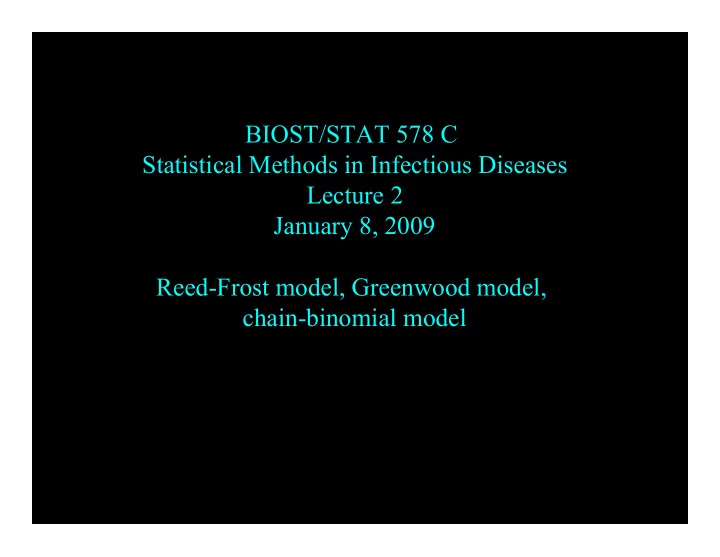

BIOST/STAT 578 C Statistical Methods in Infectious Diseases Lecture 2 January 8, 2009 Reed-Frost model, Greenwood model, chain-binomial model
Today’s Lecture � History (with pictures and movies) History (with pictures and movies) � � Derivation of the model (traditional way) Derivation of the model (traditional way) � � Extensions and points about the model Extensions and points about the model �
Course Website � Department Biostat: Department Biostat: � http://courses.washington.edu/b578a/ http://courses.washington.edu/b578a/ � Courses Courses � � BIOS 578A BIOS 578A �
Reed-Frost Model History � P. D. En P. D. En’ ’ko (1889) ko (1889) � � L. Reed & W.H. Frost (1930) L. Reed & W.H. Frost (1930) � � M. Greenwood (1931) M. Greenwood (1931) � � H. Abbey (1952) H. Abbey (1952) � � L. Elveback, J.P. Fox, E. Ackerman (1960) L. Elveback, J.P. Fox, E. Ackerman (1960) �
Reed-Frost Model Lowell Reed Wade Hampton Frost 1880–1938 1886 - 1966 Both Former Deans: Johns Hopkins School of Public Health
Helen Abbey Eugene Ackerman 1915 - 2001 1920 -
Extensions of the Reed-Frost Model � Pandemic influenza in entire US Pandemic influenza in entire US � � Containment of pandemic influenza at the Containment of pandemic influenza at the � source source � Control of endemic cholera in Bangladesh Control of endemic cholera in Bangladesh � with killed oral vaccines with killed oral vaccines
Pandemic Influenza in the US , R 0 = 1.9 Logical Outcome of Reed-Frost Model
Vaccination post-alert; 10M doses/week for 25 weeks of low-efficacy vaccine, R 0 = 1.9
Containment of Pandemic Influenza in SE Asia
Simulated pandemic influenza outbreak R 0 = 1.4 Without intervention 80% TAP Longini et al. Science 2005; 309: 1083-1087
Cholera in Bangladesh Control with Killed Oral Vaccine
Reed-Frost Model Stochastic process: discrete state space and time t 0 , t 1 , t 2 …. � Infectious agent natural history Infectious agent natural history � Infectious for one time unit � Infectious for one time unit � � Social contact structure Social contact structure � Random mixing � Random mixing � q, probability two people make contact probability two people make contact � p = 1 p = 1 – – q, � sufficient to transmit sufficient to transmit � R R 0 = (n 0 = (n- -1)p 1)p �
Reed-Frost Model ⎛ ⎞ S − ( ) S I ⎜ ⎟ = − ≥ + ( , ) t ( 1 ) 1 , , I I I t t + P I S I q 1 q S I ⎜ ⎟ t t t + + 1 1 t t t t t ⎝ ⎠ I + 1 t = − , S S I + + 1 1 t t t = + , R R I + 1 t t t + + = ∀ , , S I R n t t t t = − = = = = = [ ( 0 ) 1 ] 1 , [ ( 0 ) 1 ] 1 , [ ( 0 ) 0 ] 1 P S n P I P R { } , S I is a Markov chain = 0 , 1 ,... t t t See chain binomial chapter in the Encyclopedia Biostat., Vol 1, 593-7
Greenwood Model ⎛ ⎞ S − ( ) S I ⎜ ⎟ = − ≥ + ( , ) t ( 1 ) 1 , , I I I t t + P I S I q 1 q S I ⎜ ⎟ t t t + + 1 1 t t t t t ⎝ ⎠ I + 1 t = − , S S I + + 1 1 t t t = + , R R I + 1 t t t + + = ∀ , , S I R n t t t t = − = = = = = [ ( 0 ) 1 ] 1 , [ ( 0 ) 1 ] 1 , [ ( 0 ) 0 ] 1 P S n P I P R { } , S I is a Markov chain = 0 , 1 ,... t t t
Reed-Frost Model = − ( 1 ) R n p 0 Threshold theorem: When R 0 ≤ 1, then no epidemic, I When R 0 >1, then epidemic with probability ⎛ ⎞ 0 1 ≈ − ⎜ ⎟ 1 ⎜ R ⎟ ⎝ ⎠ 0
Lowell Reed, 1950’s
Simulated Reed-Frost Model * � Start with (S Start with (S 0 ,I 0 ≥ 1 1) ) 0 ,I 0 ≥ � ∈ � For each S For each S 0 , generate random number x generate random number x ∈ 0 , � [0,1] [0,1] � If x If x ≥ ≥ q then person becomes infected , then person becomes infected Io , q Io � � Repeat for next generation and update states Repeat for next generation and update states � � Stop when Stop when S S 0 = 0 or I 0 = 0 0 = 0 or I 0 = 0 � *First done by Elveback and Varma (1965)
* * Source: Elveback and Varma (1965)
Reed-Frost-Greenwood Simulation CHNBIN � Put CHNBIN.EXE and CHNBIN.OUT in Put CHNBIN.EXE and CHNBIN.OUT in � same directory same directory � Click on CHNBIN.EXE Click on CHNBIN.EXE � Enter values � Enter values � � Output will be in CHNBIN.OUT Output will be in CHNBIN.OUT �
Recommend
More recommend